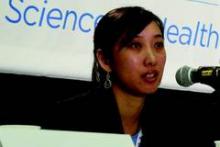SAN DIEGO – Breast cancer survivors face an increased risk of thyroid cancer, especially within 5 years of their breast cancer diagnosis, according to results from large retrospective analysis.
“The results of this study prompt a greater awareness of the increased risk for thyroid cancer among breast cancer survivors,” Dr. Jennifer H. Kuo said during a press briefing at the meeting of the Endocrine Society.
Although the incidence of breast cancer has been stable in the last 2 decades, “it’s still a leading cause of cancer; it affects one in eight women in this country at some time in their lives,” said Dr. Kuo of the division of GI/endocrine surgery at Columbia University, New York. “With advancements for the treatment of breast cancer, however, survival after breast cancer has greatly improved, now reaching almost 90% at 5 years. What this means is the number of breast cancer survivors in this country is now increasing. These survivors have an 18%-30% risk of developing a second cancer. Most of these second cancers are hormonally mediated, such as ovarian and uterine cancers, but there are some studies that indicate thyroid cancer is also increased.”
To date, she said, the relationship between breast and thyroid cancer has been largely based on findings from single-center studies, which have suggested a possible increase in thyroid cancer incidence after breast cancer. To further explore this relationship, Dr. Kuo and her associates evaluated the National Cancer Institute’s Surveillance, Epidemiology, and End Results 9 (SEER 9) program to identify individuals diagnosed with breast cancer and/or thyroid cancer between 1973 and 2011. In all, they identified 704,402 patients with breast cancer only, 49,663 with thyroid cancer only, and 1,526 patients who developed thyroid cancer after breast cancer.
The 10-year risk of thyroid cancer in breast cancer survivors, compared with the general population, was highest among those aged 40 years and 50 years (16% and 12%, vs. 0.33% and 0.35%, respectively), and lowest among those 60 years and 70 years old (0.05% and 0.02% vs. 0.33% and 0.27%). Breast cancer survivors developed thyroid cancer a median of 5 years after their primary diagnosis.
Breast cancer survivors who developed thyroid cancer were younger compared with patients who had breast cancer only (a mean of 54 years vs. 61 years, respectively; P less than .001), had smaller breast cancers (a mean of 15 mm vs. 18 mm; P less than .001), a greater percentage of invasive ductal carcinoma (7.6% vs. 5.5%; P = .002), and were more likely to receive adjuvant radiation therapy (48% vs. 44%; P = .009). “This is probably reflective of the surgical treatment that these patients receive,” Dr. Kuo said.
No differences between the two cohorts were noted in terms of estrogen receptor/progesterone receptor positivity or lymph node involvement.
Because breast cancer doesn’t generally develop in younger women, breast cancer survivors in the SEER 9 database who then developed a subsequent thyroid cancer were older, compared with patients who had thyroid cancer only (a mean of 62 vs. 45 years, respectively; P less than .001). In addition, compared with patients who had thyroid cancer only, breast cancer survivors who developed thyroid cancer had smaller thyroid tumors (11 mm vs. 13 mm; P = .004) and less radioactive iodine positivity (46% vs. 37%; P less than .001). They also had a greater percentage of tall cell variant papillary thyroid cancer (.9% vs. .5%; P = .036), oxyphilic variant follicular thyroid cancer (4.3% vs. 2.6%; P less than .001), and anaplastic cancer 1.5% vs. 0.8%; P = .001).
Dr. Kuo plans to investigate if tamoxifen treatment plays a role in increasing the risk of thyroid cancer in breast cancer survivors. She reported having no relevant financial conflicts.
On Twitter @dougbrunk


